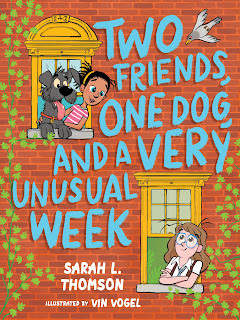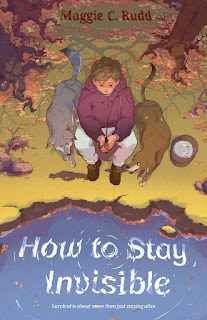Midsummer Middle-Grade Reading
Midsummer Middle-Grade Reading
My favorite childhood memories usually center around reading--the excitement of a new stack of books from the library, the ability to immerse myself in the characters' worlds.
All these decades later, I still feel the same way! On my blog Book Q&As with Deborah Kalb this month, I interviewed some middle grade authors whose books would fit the bill for satisfying midsummer reading.
 Laura Segal Stegman is the author of The Chambered Nautilus, the third in her Summer of L.U.C.K. trilogy. I asked if her three characters--Darby, Justin, and Naz--had changed over the course of the series. "Yes, very much so, and not only because the trilogyspans three summers," she said. "They each come to camp struggling with communicating invarious ways. By the end of Summer of L.U.C.K., they've found their voices andformed an enduring friendship with each other and the ghostly Mr. Usher. Ready or Not is told from Justin's point of view as helearns to stand up to a bully, building leadership skills that carry over toThe Chambered Nautilus's story. And in the third book, the three kids learnthat their close friendship need not take away from their ability to growseparately into who they want to be."
Laura Segal Stegman is the author of The Chambered Nautilus, the third in her Summer of L.U.C.K. trilogy. I asked if her three characters--Darby, Justin, and Naz--had changed over the course of the series. "Yes, very much so, and not only because the trilogyspans three summers," she said. "They each come to camp struggling with communicating invarious ways. By the end of Summer of L.U.C.K., they've found their voices andformed an enduring friendship with each other and the ghostly Mr. Usher. Ready or Not is told from Justin's point of view as helearns to stand up to a bully, building leadership skills that carry over toThe Chambered Nautilus's story. And in the third book, the three kids learnthat their close friendship need not take away from their ability to growseparately into who they want to be."
 Sarah L. Thomson wrote Two Friends, One Dog, and a Very Unusual Week. I asked about the inspiration for the novel, and she said, "The Pippi Longstocking stories were a favorite when I wasgrowing up. I was a goody two-shoes as a kid (and to be honest, I still kind ofam). That’s probably why I loved Pippi so much—a fearless free spirit who’snever even heard of a rule!" She added, "I began to wonder how a Pippi-like character would fare intoday’s society, where kids have much less freedom than they did back in 1945,when Astrid Lindgren created Pippi. Rani popped into my head, perched in anarmchair aboard a moving van—and Two Friends got its start."
Sarah L. Thomson wrote Two Friends, One Dog, and a Very Unusual Week. I asked about the inspiration for the novel, and she said, "The Pippi Longstocking stories were a favorite when I wasgrowing up. I was a goody two-shoes as a kid (and to be honest, I still kind ofam). That’s probably why I loved Pippi so much—a fearless free spirit who’snever even heard of a rule!" She added, "I began to wonder how a Pippi-like character would fare intoday’s society, where kids have much less freedom than they did back in 1945,when Astrid Lindgren created Pippi. Rani popped into my head, perched in anarmchair aboard a moving van—and Two Friends got its start."
 Caroline Palmer's new book is the graphic novel Camp Prodigy. I asked Palmer about whether they began with the text or the illustrations--or worked on both simultaneously. "There was some overlap, but I came upwith the story in a good amount of detail before starting to draw it out," they said. "A lot of people have the two processesseparated; they’ll write out a script (like a movie!) before drawing anythingat all. I find it hard to work that way. After all, comics are a combination ofwords and art–when words aren’t enough, art can be relied on, and vice versa. All this to say, I like to work out thedialogue and pages simultaneously via thumbnail sketches. I feel like mystories have better pacing that way."
Caroline Palmer's new book is the graphic novel Camp Prodigy. I asked Palmer about whether they began with the text or the illustrations--or worked on both simultaneously. "There was some overlap, but I came upwith the story in a good amount of detail before starting to draw it out," they said. "A lot of people have the two processesseparated; they’ll write out a script (like a movie!) before drawing anythingat all. I find it hard to work that way. After all, comics are a combination ofwords and art–when words aren’t enough, art can be relied on, and vice versa. All this to say, I like to work out thedialogue and pages simultaneously via thumbnail sketches. I feel like mystories have better pacing that way."
 Maggie Rudd is the author of How to Stay Invisible. When I asked about the inspiration for her novel and for her protagonist, Raymond, she said, "I was walking through the woods behind the school where Iworked, and I saw a huge fallen tree. The roots were ripped up from the earthand there was a huge hole through the center of the root system. I stuck myhead inside to get a better look, and I thought, Wow, someone could live inhere. The thought bloomed and blossomed and turned into a book. The character, Raymond, is loosely based off of severalstudents whom I consistently worried about, but he definitely developed intohis own person with his own unique personality and problems."
Maggie Rudd is the author of How to Stay Invisible. When I asked about the inspiration for her novel and for her protagonist, Raymond, she said, "I was walking through the woods behind the school where Iworked, and I saw a huge fallen tree. The roots were ripped up from the earthand there was a huge hole through the center of the root system. I stuck myhead inside to get a better look, and I thought, Wow, someone could live inhere. The thought bloomed and blossomed and turned into a book. The character, Raymond, is loosely based off of severalstudents whom I consistently worried about, but he definitely developed intohis own person with his own unique personality and problems."
Happy summer reading!
--Deborah Kalb
Published on July 02, 2024 03:00
No comments have been added yet.



